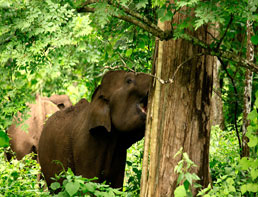Kerala.com Travel Division
WorldViewer Dot Com (India) Pvt. Ltd.
II Floor, G 66, Elders Forum Road
Panampilly Nagar, Cochin, Kerala, India
Pin - 682 036
Mobile: + 91 98460 43403
Mobile: + 91 93886 40364

 The Wayanad wildlife sanctuary is located 18 km east of Sultan Bathery. It actually spreads into two regions of Kerala - Cannanore in the north and Calicut in the south. An intrinsic part of the Nilgiri Biosphere, the Wayanad wildlife sanctuary of Kerala is joined to two other wildlife parks - Nagarhole and Bandipur of Karnataka on the northeast and Mudumalai of Tamil Nadu on the southeast. The sanctuary was formed in the year 1973 and was brought under the Project Elephant in the year 1991-92.. Occupying an area of 345 sq km, the Waynad wildlife sanctuary happens to be the second largest one in the state of Kerala.
The Wayanad wildlife sanctuary is located 18 km east of Sultan Bathery. It actually spreads into two regions of Kerala - Cannanore in the north and Calicut in the south. An intrinsic part of the Nilgiri Biosphere, the Wayanad wildlife sanctuary of Kerala is joined to two other wildlife parks - Nagarhole and Bandipur of Karnataka on the northeast and Mudumalai of Tamil Nadu on the southeast. The sanctuary was formed in the year 1973 and was brought under the Project Elephant in the year 1991-92.. Occupying an area of 345 sq km, the Waynad wildlife sanctuary happens to be the second largest one in the state of Kerala.
The sanctuary is separated into two disconnected parts known as the Upper Wayanad wildlife sanctuary (Tholpetty) in the north and Lower Wayanad wildlife sanctuary (Muthanga) in the south. The area in between the two parts was orginally a forest region, though it is now occupied by plantations. Till date, a number of dispersed human settlements can be found in the sanctuary area.The term Wayanad literally means land of swamps. A visit to the sanctuary offers tourists a chance to witness the efforts made by the management to conserve the biological reserve of the park. The scenic beauty and the variety of flora and fauna also keep the visitors busy and entertained.
Undulating landscape
The undulating landscape of the Wayanad wildlife sanctuary is covered with moist deciduous teak forests and semi evergreen tree pastures. The floral variety of the park range from Teak, Bamboo, Maruthu, Karimarithi, Rosewood, Venteak, Vengal, Chadachi, Mazukanjirarn (deciduous type) to Veteria indica, Lagerstroemia, Lanceolta, Terminalia Paniculata (semi evergreen type). Among animals, the Elephant occupies the prominent position though there are a decent number of Tigers in the park as well. Other wild animals that can be sighted here include Panthers, Jungle Cats, Civet Cats, Monkeys, Wild Dogs, Bisons, Deer and Bears.The reptile population is also fairly good with a number of snakes species sighted here. Monitor Lizards are quiet common in this park.Peacock, Babbler, Cuckoo, Owl, Woodpecker and Jungle Fowl are a few of the numerous birds that are seen flying in the park. It is a pleasure to watch as these birds go about their usual tasks collecting food for their young ones and themselves.
Tourists can explore the flora and fauna of Wayanad wildlife sanctuary on board a jeep. This is an excellent option to remain safe as well as increase the chances of animal sighting. However prior permission is required to be taken from the Forest Department for this purpose. You also need to take along a guide provided by the Forest Department compulsorily. It is to be noted here that the elephants of Wayanad wildlife sanctuary are more violent than their brethren in other sanctuaries of Kerala. Hence, proper precaution needs to be undertaken during your jeep safari trip. The best time to visit the wildlifeWayanad is between the months of June to October.
For other tourist attractions in and around the green paradise, log on to wayanad.com
For Accommodation - Hotels / Resorts / Homestays in Wayanad
WorldViewer Dot Com (India) Pvt. Ltd.
II Floor, G 66, Elders Forum Road
Panampilly Nagar, Cochin, Kerala, India
Pin - 682 036
Mobile: + 91 98460 43403
Mobile: + 91 93886 40364

Kerala Districts : Alappuzha | Ernakulam | Idukki | Kannur | Kollam | Kottayam | Kozhikode | Kasargod | Malappuram | Pathanamthitta |Palakkad | Thiruvananthapuram | Trichur | Wayanad
Other Destinations :Nelliyampathy | Kodanad | Fortkochi | Marari | Kulamavu| Cherai | Kanyakumari | Kumbalangi| Kuttikanam | Ramakkalmedu|Vaikom |